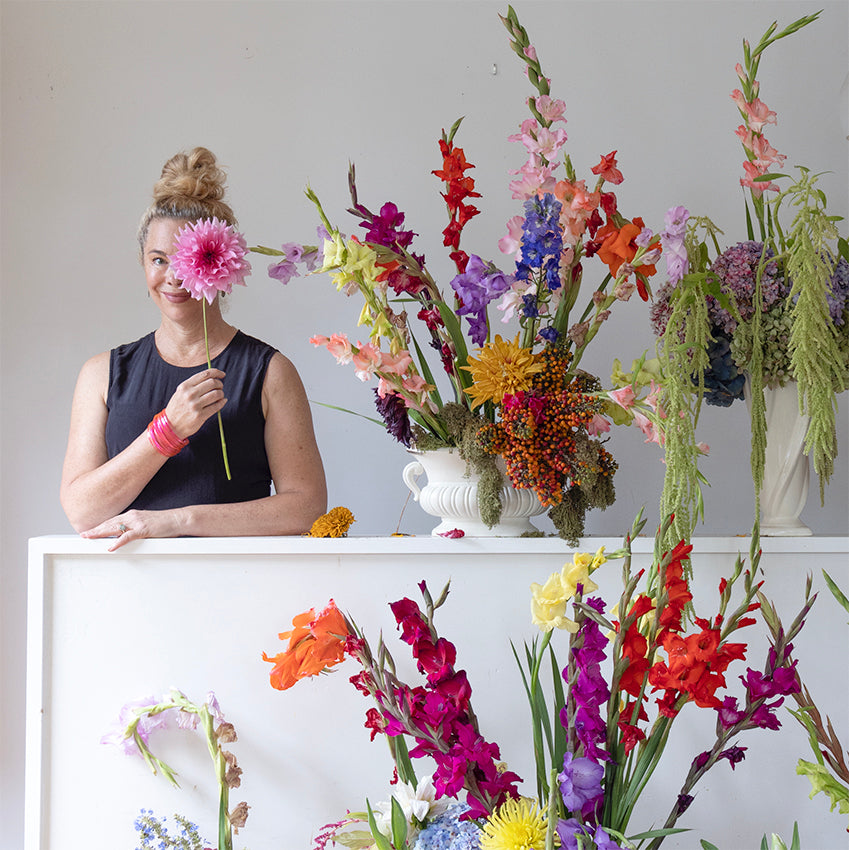Good to be in Good Magazine
April 27, 2018

How this floral artist and photographer’s works provoke critical thinking on societal ideals and taboos.
It immediately becomes clear after stepping into artist Emma Bass’ home is that this is a woman who is besotted with flowers. There are floral spectacles adorning every mantelpiece, table and cabinet in sight. I find Bass in her studio busily multitasking, snapping shots and rearranging a hibiscus flower as part of the vibrant masterpiece she is creating. Her attention to detail is remarkable. “Isn’t it just magnificent,” she remarks while rearranging the shot, then running out to her garden to scavenge for a hydrangea flower. Flowers have been the primary subject of Bass’ work for more than six years, but she seems to fall in love with them even more by the minute. I asked her about the messages in her work, and why it brings her a resounding sense of purpose.
Your career has lasted 25 years, how has it evolved?
I’ve always seen the world in a compositional way and through a lens. It all started while I was working as a nurse in London during the late 1980s. I did a photography course in Leicester Square and I was completely hooked. I came back to New Zealand where I properly trained for two years and started my career with editorial and commercial photography, mostly concentrating on people.
How did you get into floral composition and photography?
I was shooting a cover for a magazine and we were photographing a person but we needed something to fill in the background. So I suggested some flowers. There were some magnolia trees on the roadside which I grabbed, and threw together in one of my white vases. They had marks all over them because there had been a hailstorm, but I knew the flowers weren’t going to be in focus, so I overlooked their imperfections. Afterwards, when everyone had left, I couldn’t help but photograph them. My neighbour saw this and wanted a print for her wall. It was because they were imperfect that she found them so beautiful. I started exploring the whole idea of imperfection and how in our society, there’s a drive to be perfect. Trying to achieve perfection will drive you insane and I am a self-confessed perfectionist, so it was great going down the road of being imperfect, looking for things that weren’t perfect to bring to light. I had an exhibition [called Imperfect] and haven’t looked back. I think people find the images reassuring.
Nature and flowers are a big inspiration for your work. Why?
Flowers have been employed to represent our ideas and emotions as far back as we can trace our artistic heritage. Eastern or Western. Flowers are one of the most universal forms of beauty, tokens of love, a natural expression of the environment. It speaks to the universality of beauty. Everywhere in the world, flowers are cherished in some form. Nature is the most pure, beautiful thing. Our world has become very detached from nature, so my work is a lovely way to have nature in your environment and in your home. I am meditative when I create the work and it’s my way of connecting with, and studying, nature. Nothing is perfect in life but there’s still a beauty in it all. Death is a taboo subject which I am interested in, because being an ex-nurse, some of my most rewarding experiences were nursing dying people. We know that the flowers are going to die at some point but they are beautiful in their decay. We are all heading towards demise and I am interested in demystifying the whole idea of death. In difficult circumstances we can still meet beauty. I am very interested in getting my work into places of healing.
What is your most recent series, Embellish about?
Imperfect led to Embellish, my new body of work. Our world is embellished, our lives are embellished, the news is embellished, we increasingly embellish ourselves ... you don’t know what’s real anymore. Having photographed a lot of well-known people over the years, I’ve observed women obsessed with the way they look. We all self-embellish in different ways. For example, I sometimes feel naked without a good lipstick on. The bouquets have all been embellished in some way, fake flowers combined with real flowers, some are painted, some are embellished with objects. I am interested in the idea of, if you know if something is false, is it any less beautiful because it is ‘inauthentic’? How do you define beauty? Does something have to be ‘real’ for it to be beautiful?
You also incorporate the Japanese art of repairing broken pottery, Kintsugi, into some of your works.
I love the philosophy of kintsugi, which is the art of repairing broken pottery with gold. The object becomes more beautiful once it’s actually broken and repaired. It really resonated with me – so with my broken vases (they sometimes arrive in more than one piece, and sometimes they have been casualties of my children’s play) I taught myself how to kintsugi. There’s the infamous Leonard Cohen lyric: “Forget your perfect offering, there is a crack in everything, that’s how the light gets in.”
Which artists inspire you?
I have a house filled with floral art, including a massive flower sculpture by Geoff Thompson. I like to be surrounded by all flower forms. I love the work of English artist Ann Carrington who makes incredible sculptures of flower arrangements out of English silver cutlery. Karl Blossfeldt did beautiful botanical studies in the early 1900s, and I love the Dutch Masters, which I’ve found inspirational for my Embellish work. In 2016, I had a work accepted into the Royal Academy Summer Exhibition in London and while there I visited a Dutch flower still life exhibition at the National Gallery. To see these exquisite masterpieces up close in the flesh was quite a pivotal moment.
What are your plans for the rest of 2018?
Two works from my Embellish series will be going to an exhibition in London at the Daniel Raphael Gallery. It’s a collaborative show of contemporary artists showing floral work. I am also working on two brand new bodies of work at the moment. I’m very excited to see how they develop as I get more involved with them. Of course, it’s all quite a juggle with two wonderful children to look after, but I have become a master of multitasking.
“Nothing is perfect in life, but there’s still a beauty in it all.”

Also in News
Yes! I would like to receive news from Emma Bass





